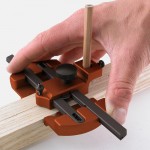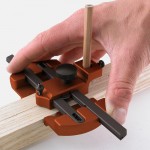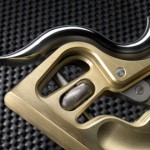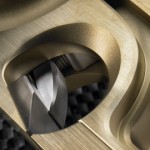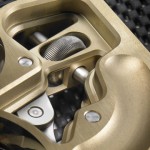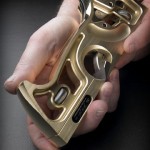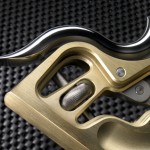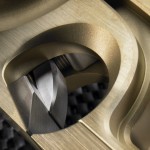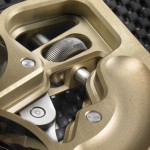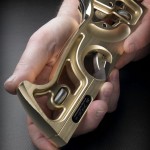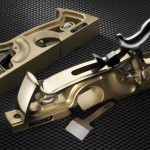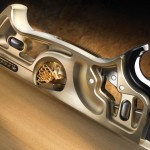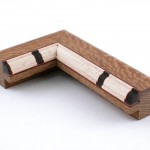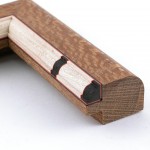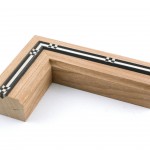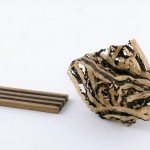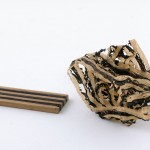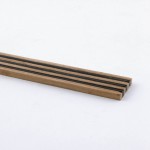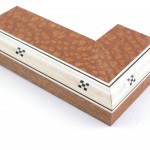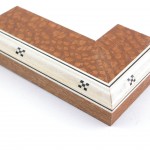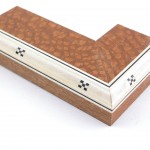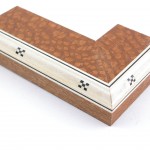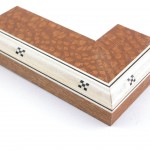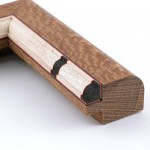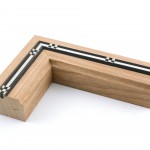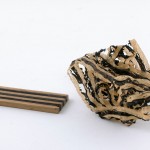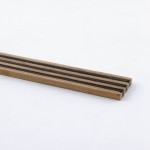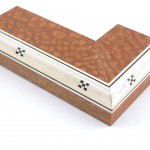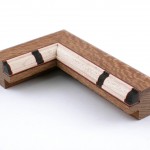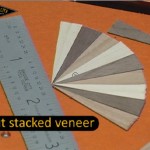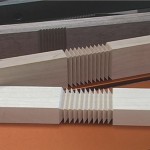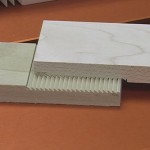Light-tight dovetail joints are a hallmark of craftsmanship. The video below illustrates how we make through dovetails using the Jointmaker Pro. In the interest of saving a few megabytes of bandwidth, a little background information is in order…
“Traditional methods” are important, perhaps pertinent, but often times I feel the urge to try ideas that are not 300 years old. That said, the only aspect of dovetailing in this video that is “traditional” (it is such a regressive word) is waste removal by chisel. The rest should be an enlightening combination of speed and accuracy–and easily replicable.
When setting the blade (or the fence) of the Jointmaker Pro to a particular angle, we make practice cuts on wide stock until the stock nests perfectly to a reference (t-bevel or square). All of the prep work for this video was done off camera.
Regarding pins vs tails first, I embrace “whatever works for you”. However, with the Jointmaker Pro we are definitely pro tail (socket) first. The reason is simple, we did not need to layout the tails. You will see us using a stop block for joint symmetry. We also made all of the tail cuts by cutting from both faces of the stock with the blade set at the same angle–this ensures the single pass cuts are also dead symmetrical–this is much faster incredibly accurate…more on this at the end.
By making a zero clearance throat plate, we can make single pass cuts to either side of a line with ease–and so can you. We used 1/8″ aircraft plywood for the false tables and the throat plate. (You only make these once, they can be used over as often as needed.) The video shows minimal layout to mate the pins to the tails–that is all that is required and pencil tic marks worked fine. Of course, you can use whatever method you prefer–we only care about a light-tight joint.
I think you will agree, the saw cuts cannot be improved–by any method. And if you had a complete project (as opposed to our single sample joint) we believe there is not a faster way to hand cut dovetails. Of course layout can be expanded for more complex joints but you don’t need much–the saw does the work perfectly without the need for a thorough visual reference. The saw (assuming a sharp blade) cannot cut crooked unless your set-up was crooked. In short, the Jointmaker Pro reliably cuts your intent, cut after cut without you worrying about accuracy.
It is incredible to think that EVERY cut is exactly the same depth and perfectly angled. Lastly, this was a first take video and we spent no effort on the proportions of the half and full pins. We just made cuts and chiseled away and you will never guess what happened. I could fit the tails onto the pins from either direction, and that has NEVER happened to me before.
What fun!
–John
PS: I am working on a way to cut half-blind dovetails. I will let you know if I succeed…
If you have a woodworking friend who would like to see this video and not wade through my ramblings, here is the YouTube link:
http://www.youtube.com/watch?v=l_eyFENlSQ0&fmt=18
The Center Scribe after 520 payroll periods…
June, 26th, 2008
Thanks to the British Weights and Measures Act of 1824, we Americans inherited a collection of units known as the Imperial system. Imperial units are unbelievably accurate and superior to the metric system in every way–and I can prove it with a singular question:
What is 17-17/32″ divided by three?
And you thought a six-star Sudoku puzzle was hard.
Fortunately, woodworkers are constantly dividing things in half, a much easier task than the gasket blowing problem above (5-27/32″ is the correct answer–took me a day and a half, or .15 payroll period to figure this out ). Try it yourself–dividing 17-17/32″ by two only took me four hours.
Approximately 520 payroll periods ago, we introduced the CS-1 Center Scribe, a cool tool to help Inch Land woodworkers find the center of things without time-consuming calculations. Inchlanders often struggle with the efficiency of Imperial measurements and our CS-1 Center Scribe quickly became one of our most sought after tools to this day.
About 104 payroll periods ago, improvements to the CS-1 came upon me. Fully charged for the redesign, the muse arrived unannounced bearing news of the VP-60 Adjustable Pitch Plane. Immediately thereafter, who should reappear with a radical new design for shoulder planes? And for the past year, I have been obsessed with the Jointmaker Pro–likely the most scrutinized new tool introduction I’ve known.
The image below is of our new, improved Center Scribe.
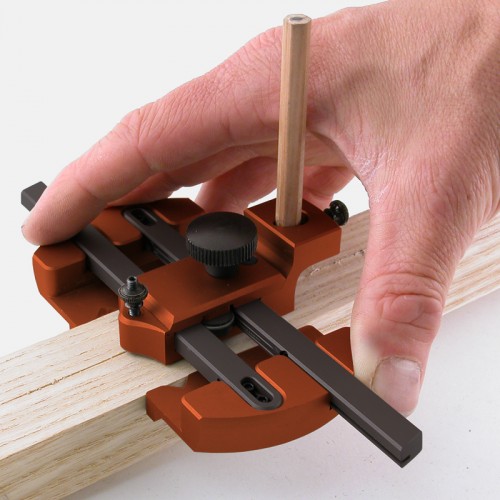
Briefly, here are the improvements;
- Zero backlash or slippage–no gears.
- Holds a pencil
- Finds centers on square, round or rectangular stock lightning-fast.
- Does not react with humidity
- Field adjustable if needed
- Smoother feel
- More precisely scribed centerlines (not pencil lines for obvious reasons), accurate to within .002″
To learn more, visit the CS-2 Center Scribe pre-production page. And if the CS-2 looks like something you can use, click the panel that states “Notify me when this item is back in stock.” By adding your name to this database we have a much better idea of our manufacturing quantities–you are not placing an order.
Thanks to a suggestion by a good engineering friend, this tool is crazy smooth and accurate. I hope you like it because… well, it’s a payroll thing.
-John
Free Food and Dead Cicadas…and that is the truth.
June, 19th, 2008
Well, it’s a little after midnight and AGAIN I find it hard to go to sleep. I just spent almost 12 hours on the Popular Woodworking campus talking about the Jointmaker Pro. Although this trip was all about business, I would not dare call it work, only because there was free food, and plenty of dead cicadas… DETOUR: We don’t have cicadas in Oregon (if we do I am sure someone will correct me) and this much dead biomass is fascinating. And loud. Before they die that is. Do the math here–17 years as a hibernating nymph buried next to a big, fat tree root, wake up hungrier than a teenager without a refrigerator, munch on tree sap until the libido overwhelms, spend a couple of hours at the screaming mimi cicada bunny ranch and then croak from exhaustion… This isn’t so bad when you think about it…no SAT tests, background checks, or exit polls–just an incredible, one week, no-strings-attached love fest. Reincarnation requests anyone? How about a Jamba Juice Tree Sap Smoothie?
I digress. Approximately 60 people ventured into Cincinnati to eat free pizza and listen to my Silent Woodworking spiel. (Not quite as bad as one of those guilt ridden timeshare meetings…I hope.)
It is hard to tell if people had a good time, but I found it fun. As many of you know, Chris Schwarz claimed that the cut from the Jointmaker Pro was the cleanest saw cut he has ever seen–by any method. Of course the Woodworking Taliban pilloried him for such nonsense and I believe, if any of the attendees step forward, his critics will join the cicadas in the belly of a street sweeper.
After my presentation, the Jointmaker Pro was moved to the shop and all interested were allowed to make cuts. There were plenty of smiles–and frankly that was worth the trip. I am leaving the prototype with the Popular Woodworking crew for the next month for further play and testing. Oh, and a small detail — nobody lost any digits.
I was treated like a dignitary (I am not, and NEVER want to be) so I had four pieces of pizza, two of which were onion–without which we would still be talking about the Woodworking Taliban at a local watering hole. Smart people, those Popular Woodworking folks.
–John
The Jointmaker Pro and FREE Food-June 19
June, 2nd, 2008
Thanks to a gracious invite from Chris Schwarz and the Popular Woodworking staff, I will be heading out to Cincinnati for a June 19 presentation on “Silent Woodworking”. This will be an informal, up-close and personal affair centered around our new Jointmaker Pro and several new profiles for the HP6-v2 Mini Multi-Plane. These folks are passionate about hand woodworking and Chris and staff are terrific hosts. The event is F-R-E-E and includes a buffet of real food. Everybody is welcome to give the Jointmaker Pro a go before I go–you will be amazed at what can be done without a power cord.
We are limited to the first 60 attendees because the Cincinnati fire marshal just does not get the concept of free food and woodworkers. Dinner begins at six and if you can make it, I would love to meet you in person (Chris too). In addition to a couple of surprises I have up my sleeve, these things have a habit of spilling over to a local bingo hall afterwards for more serious discussions.
RSVP ASAP via email to Megan Fitzpatrick; Megan.Fitzpatrick@fwpubs.com
I hope to see you there!
-John
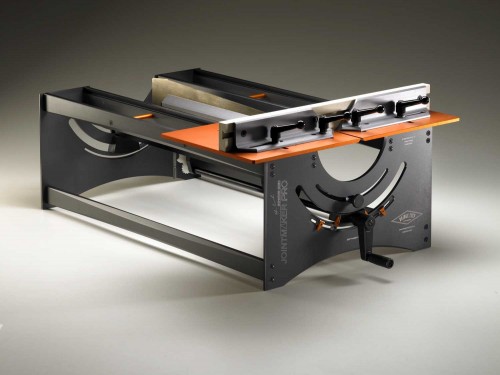
The Jointmaker Pro can do things without power that are unimaginable. It is an impressive tool that you can try yourself on June 19th in Cincinnati.
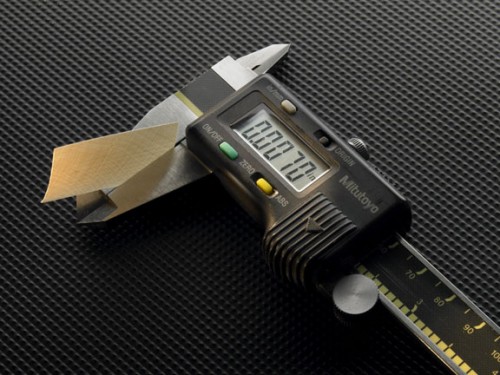
This image vividly illustrates the accuracy capabilities of the Jointmaker Pro. The material is hard-rock maple and was made with 10 strokes.
HG-1 Honing Guide in Action
It is always fun around here when an idea becomes reality. Later this week our new honing guide will be in stock. Although I designed this tool with the specific needs of sharpening our HP6 profiled irons in mind, it will work on just about every tool in your shop. Here’s a peek of the tool in action…
As you can see, the rear roller is flat. We have had several inquiries regarding a roller that is crowned to facilitate relieving the corners of wide plane irons. Although this sounds like a good idea, the math makes no practical sense. For example, if one wants to relieve the corners of a plane iron by .002″-.003″, the crown in the honing guide roller would be around .001″. This is just not a practical idea (in our opinion) when the same results can be achieved with finger pressure applied to each corner during honing. If a more severe crown is required, a barrel shaped roller might make sense, and if you have that need, you can easily remove the stock roller and insert a shop made roller (wood will work) for your needs.
Lastly, it is not clear in this clip but the clamping bridle pivots and will accommodate aggressively tapered tools–the most common of which are Japanese chisels.
Thanks for watching.
-John
It’s Time to Say Goodbye–for the 14th Time
May, 27th, 2008
Each year, for the past 14 years, we have produced a limited edition Commemorative Tool with the pledge to never make its identical version again. Last year’s edition, one of the more radical designs in the series and one of the most unique, was inspired by my first real fox sighting (you can see the stylized fox profile in the rear of the tool). Commemorative Tool #14, the Fox Tail Shoulder Plane, is now completely sold out (with the exception of a couple of blems with minor cosmetic flaws) and it is time to move on–again. If you missed it the first time around, here is a detailed review of the Foxtail Shoulder plane by David Mathias.
Farewells are often softened with strong memories. The images below, courtesy of our talented photographer, Joe Felzman, are provided as a final tribute to one of my all-time favorite tools.
-John
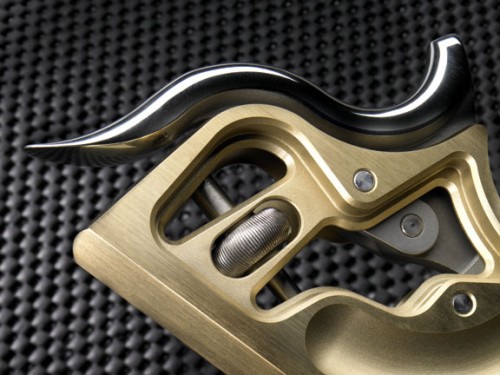
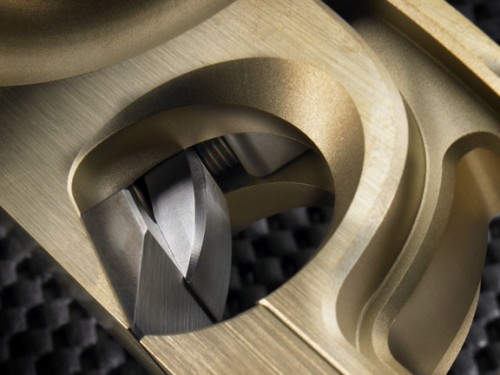
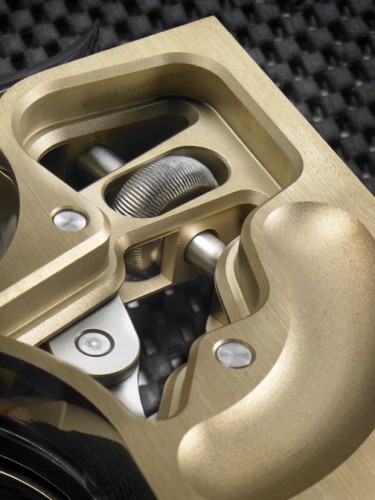
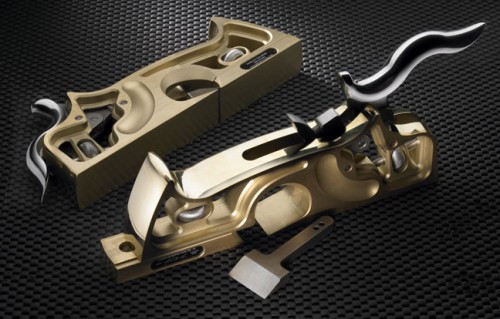
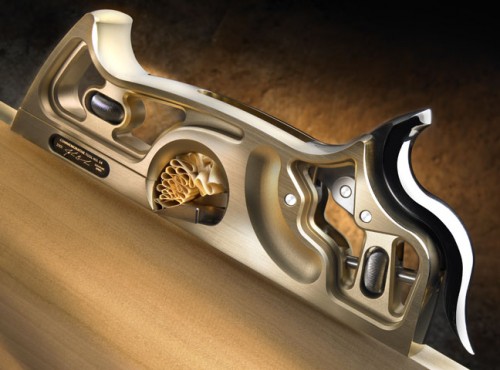
HP6v2 and the Jointmaker Pro, Silent Woodworking–Endless Possibilities
May, 21st, 2008
Our HP6v2 owners are a passionate group. The really smart customers take my summer classes at the Marc Adams School of Woodworking and upon completion enter the enchanted world of creativity and return home a woodworking genius. (I hope my kids are reading this…).
Take Rutager West for example. He bicycles twenty miles to work each and every day, all year long, in MINNESOTA! Yikes! Rutager also happens to be an equally dedicated woodworker who cannot stand the noise, the dust and the risks associated with power tools, particularly routers. Rutager makes boxes and cases. He recently told me in my “CAD for Woodworkers” class that our HP6v2 has changed his life–and cannot wait to receive his Jointmaker Pro. Now that is pretty cool, and speaking of cool, check out some of the things he has been making with the amazing little HP6v2 Mini Multi-Plane… these are details of the frames and components he shows prospective customers–all without sanding! And if you are as impressed as we are, I am certain he would appreciate reading your comments.
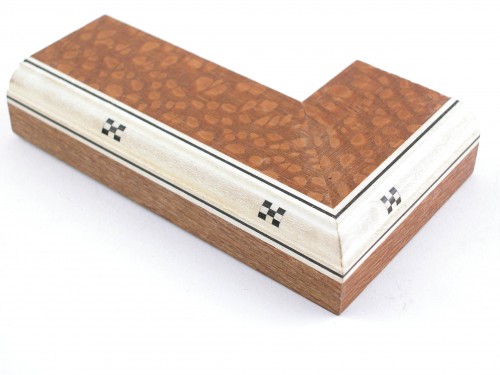
The above frame used HP6v2 Mini Multi-Plane corner bead and rabbet kits. It is stunning craftsmanship.
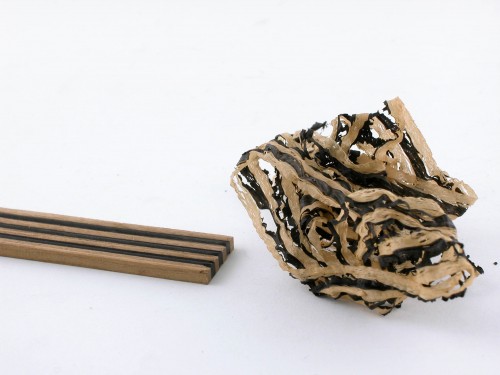
The multi-bead soles (available in four sizes) are a great way to add texture. These shavings in ebony and an unidentified hardwood speak volumes for the capabilities of the HP6v2.
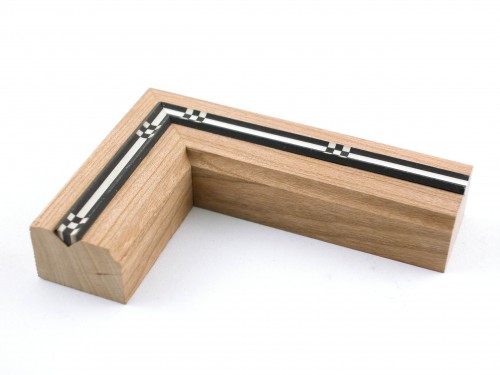
Using the V-groove sole, Rutager plowed a recess to receive the molding made with the corner cove sole which also made the cove on the edge–beautiful work. I don’t know how he makes his laminations!
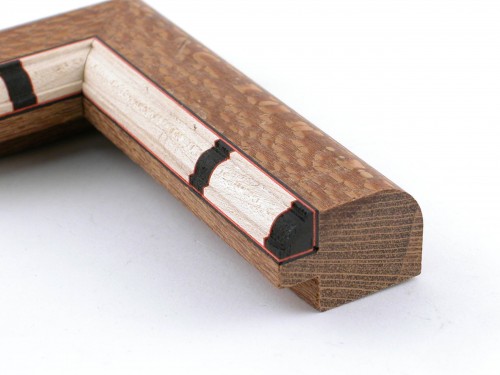
This frame detail uses the following sole/iron kits for the HP6v2; rabbet, corner bead, and corner radius–all without a grain of sandpaper.
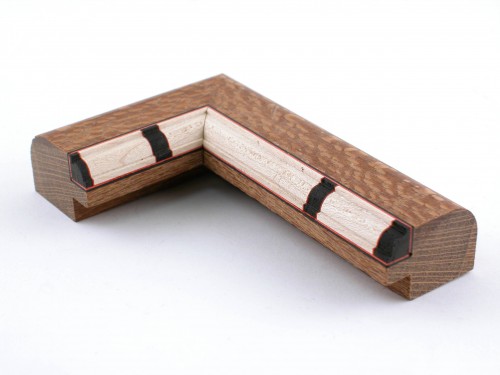
Another view–THANK YOU Rutager for sharing your work!
If you have an HP6v2 story to share, please do!
-John
Jointmaker Pro In Action
May, 8th, 2008
Here’s a little clip that shows some amazing capabilities of the Jointmaker Pro.
–John
“Indiana is the veneer capital of America…”
May, 7th, 2008
I’ve been teaching classes at the Marc Adams School of Woodworking for about 187 years now–give or take a few weeks. Mainly I enjoy the free lunches. And my students. And Marc Adams. And the occasional blank check he sends me–in that order.
Tuesday evenings feature an informal dinner where teachers respond to woodworking questions with their mouths full of food. Around 7:00 post meridian time, instructors share their work with overly satiated students who need sleep. It is really interesting and if you don’t believe me, take a class–it’s a great school.
This year I shared a working prototype of our new Jointmaker Pro saw. It is a hybrid tool, part miter box/chop saw/table saw. It requires no power, is unbelievably accurate and conversationally quiet. I was a bit nervous because I really needed live feedback by real woodworkers–hopefully positive feedback. Afterwards, in my tent by the freeway, I faded believing the demonstration went well.
The next day, Marc Adams, who ironically goes by the name of Marc Adams, shared that my presentation went well. I asked him what he thought about the new saw.
DETOUR: Marc has informed me on numerous occasions that he lives in Indiana and it is no coincidence that Indiana is the largest veneer producing state in America. It’s a long story–take my word for it and don’t bring the subject up in his presence.
So he blurts, “I bet it won’t cut veneer.” (Hallmarks of friendship include confrontational challenges, brute honesty and the assumption that your friend is listening…)
Imagine my surprise when Marc supplied me with a stack of veneer, and taught me AGAIN that IF this works, it would be called PARQUETRY, not MARQUETRY. Thanks Marc.
The picture below illustrates how cutting veneer on the Jointmaker Pro is not only fast but dead-on perfect.
I asked Marc what he thought of the results…
“They are perfect. But we don’t do it that way.”
This made me smile.
-John
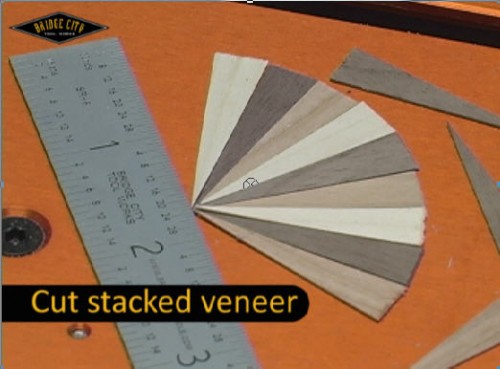
Insomnia has its rewards…
May, 5th, 2008
I don’t know why, but I wake up in the middle of the night so frequently I wonder why I go to bed in the first place. Last August, while you were likely asleep, I was wide awake fretting how woodworkers tend to put their fingers at risk when sawing small stock. Then an idea came upon me…
With patents pending, we will soon introduce a completely new way to crosscut wood and make joinery entirely by hand. And although this saw really shines with small stock, it will cut hardwood or softwood up to 6″ in width and 1-5/8″ thick, which is the vast majority of crosscuts for most. It is quiet, accurate, and the cut is so smooth no further work is necessary for cleanup. It is rather remarkable because accuracy like this has never been possible without power. There is also no need for hearing protection, dust collection and it is very safe.
Many woodworkers view new ideas with a bias towards their own skills and techniques and are slow to embrace change–woodworking is the most anachronistic hobby in America. So, over the past four months I have given demonstrations to several different groups of woodworkers to determine interest in this new way of cutting wood. We also demonstrated the saw in Cologne, Germany in March. I will write more later, but until then, check out the two images below – all of these cuts were hand sawn! We think you will agree, these images are strong indicators of a tool that rivals, and exceeds in many cases, the capability of power-hungry alternatives.
-John
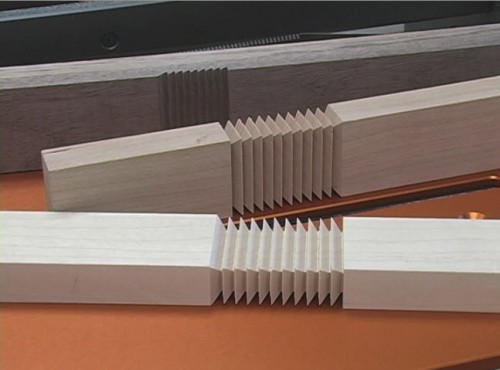
These two boards were cut entirely by hand with a new handsaw from Bridge City. The cuts are smooth, accurate and depth is consistent within .002″ on every cut. Each board took about 10 minutes and is comprised of 88 individual cuts.
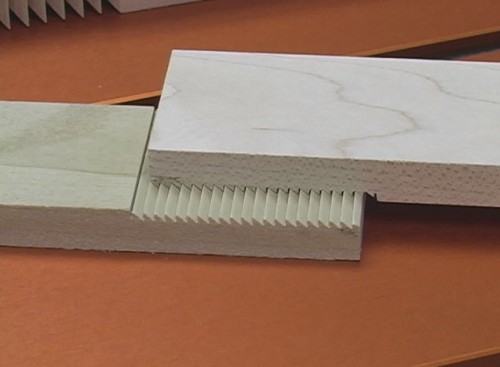
In an effort to fully understand the capabilities of our new saw, we quickly cut angled cuts into two pieces of wood and nested them. This is amazing when one considers no power was used. Each piece was cut in approximately 5 minutes and consists of 42 individual hand cuts.

